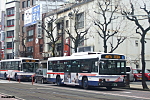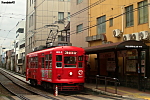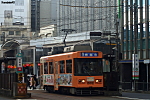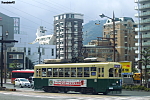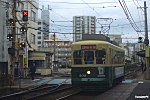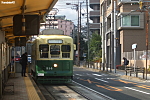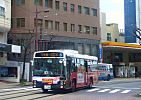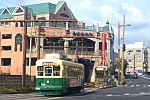Jesteś niezalogowany | Zaloguj się | Zarejestruj się

Szukaj zdjęcia
Isuzu PJ-LV234N1 Erga Non-Step #2604
11 lutego 2019 - Nagasaki (Nagasaki Pref.), Dōzamachi (長崎県長崎市銅座町). Putting aside how much I had to look for this place on Google Maps, this company has a really strange approach to passenger information. The number seen on the destination display doesn`t indicate the route as much as the destination area, or sometimes the route taken. Thus when using the stop timetables (which I already mentioned briefly under photo 1010960) one has to search for their route by the terminus name and then by the via points. The 20 seen in the photo is first the Ebira Line (江平線) towards the city centre, and second a very summary-like description of anything terminating at the Nagasaki Shinchi Terminal, or Chūō-bashi (Central Bridge). Well, the result is that timetables near the city centre look more like this...

Autor: TranslatorPS 

Miejsce: 長崎市 [Nagasaki-shi] (Nagasaki-ken)
| Właściciel: Nagasaki Bus 長崎市 [Nagasaki-shi] | Linia: 20
Komentarze: 2
Nippon Sharyō Nagasaki Denki Kidō 360 series #364
11 lutego 2019 - Nagasaki, Matsuyamamachi (長崎県長崎市松山町), Heiwa-kōen (Peace Park) tram stop. A red tram heading towards Nagasaki city centre on the red route. 125 metres to the east from this car is the epicentre point of the explosion of the second atomic bomb to have been dropped on Japan. The miserable cloudy weather stayed strong throughout the first half of my trip to Nagasaki, including my visit to the museum dedicated to the attack. Only once I`d left the museum did the clouds part - a question follows, should I look for any signs in such a meteorological turn of events?

Autor: TranslatorPS 

Komentarze: 4
Alna Sharyo Nagasaki Denki Kidō 1500 series #1502
11 lutego 2019 - Nagasaki (Nagasaki Pref.), Aburayamachi (長崎県長崎市油屋町), Shiambashi tram stop. This 26-year-old (at the time of the photo) Alna Sharyō car is only one stop away from its terminus. Along Harusame and Shiambashi Streets (legally speaking, along the final section of the Main Line, 本線 honsen) the tracks are laid down the middle of the road, and the stops are made of (really) narrow island platforms long enough for just one car at a time.

Autor: TranslatorPS 

Komentarze: 6
Hitachi Nagasaki Denki Kidō 201 series #209
11 lutego 2019 - Nagasaki (Nagasaki Pref.), Hamaguchimachi (長崎県長崎市浜口町), National Route 206. This photo shows the air-conditioning units added in 1987 rather well. Japanese Wikipedia claims that some big changes were made to the external appearance of these cars when strengthening the body for air-con installation, but I struggle to see any when comparing with a 1954 photo, aside from perhaps changes to the side scroll location and the front window shape. The red bus in the background belongs to Nagasaki Ken`ei Kōtsū, a company that I somehow don`t have a single shot of...

Autor: TranslatorPS 

Hitachi Nagasaki Denki Kidō 201 series #203
11 lutego 2019 - Nagasaki (Nagasaki Pref.), Ōbashimachi (長崎県長崎市大橋町), Urakami-shako (Urakami Depot) tram stop. All of the three-light signals seen in this photo (they always only show two lights) are shunting signals. Shunting signals of the exactly same style are used by practically all heavy railways in Japan, so it`s somewhat interesting to see them used in a tramway network as well. Signal 4 (under the red X) allows switching back on the mainline, as the track layout at the depot is quite inconvenient - in order to leave most of the depot tracks towards the city (as in head in the direction of this car), one has to pull out to the outbound platform and reverse on the mainline towards the city using one of the crossovers behind the tram in the photo. The other signals are used for pulling into one of the stabling tracks in the depot. Signal 8 seen above the platform to the right is also for entering the depot, however this is for cars on the inbound track which reverse using the platform where I`m standing. Quite a lot of shunting involved. The red X above signal 4 is to confirm point locking, as far as I remember.

Autor: TranslatorPS 

Hitachi Nagasaki Denki Kidō 211 series #214
11 lutego 2020 - Nagasaki (Nagasaki Pref.), Nakazonomachi (長崎県長崎市中園町), National Route 206, Akasako tram terminus. A brief reprieve from the Kantō area in the form of nearly the edge of the country - Nagasaki. To start this short series off, a rather peculiar terminus structure: a single bi-directional platform (which by the way is the longest in the network, at 53 metres), split into three sectors. As such, three different cars can terminate here simultaneously. However for the same reason cars depart from here in reverse order of their arrival - first to arrive, last to leave. The points splitting off to the double-track section are right at the end of the platform (behind the photographer). Akasako is also the western-most tram stop in Japan.

Autor: TranslatorPS 

Miejsce: 長崎市 [Nagasaki-shi] (Nagasaki-ken)
| Właściciel: Nagaden 長崎市 [Nagasaki-shi]
Isuzu KC-LV380N Cubic #1714
11 lutego 2019 - Nagasaki (Nagasaki Pref.), Shinchimachi (長崎県長崎市新地町).I would like to wish everyone a positive and successful New Year!
I originally intended to upload this nearly a year ago, but my spring semester didn`t agree with that idea, so I`m only getting to it now... yet the photo`s been laying around ready for all that time. The scroll is showing perahps the most popular destination in Japan - 回送 (kaisō) being any sort of deadhead/empty journey. There`s plenty of those to be seen around in Japan due to a lot of duties (from what I`ve seen) having to finish or start in the garage. And there you go, empty mileage left, right, and centre.


Autor: TranslatorPS 

Miejsce: 長崎市 [Nagasaki-shi] (Nagasaki-ken)
| Właściciel: Nagasaki Bus 長崎市 [Nagasaki-shi]
Isuzu QPG-LV234N3 Erga Non-Step #1584
11 lutego 2019 - Nagasaki (Nagasaki Pref.), Dejimamachi (長崎県長崎市出島町). A Japanese city bus operator without an Isuzu Erga? I probably mentioned it, but it`s like a British operator without an ADL.Nagasaki city buses irritated me with their lack of Latin transcription on the scrolls - something I`d only seen in Kōbe other than here. On top of that, the timetables on stops were done in the "one table for all routes" style with the different variations in separate rows - without knowing the city I could only be guessing where goes what, given the lack of any route diagrams on the stops, something that`s a blessed standard elsewhere in the country.


Autor: TranslatorPS 

Alna Sharyo Nagasaki Denki Kidō 500 series #504
11 lutego 2019 - Nagasaki (Pref. Nagasaki), Ōbashimachi, near Urakami-shako stop (長崎県長崎市大橋町). For administrative purposes, the Nagasaki tram network is split into five lines, and fundamentally services operate on four routes: 1 (blue), 3 (red), 4 (yellow), and 5 (green). The timetable also mentions the existence of a route no. 2, which operates only one lap in the evening, around 11 pm. On top of that, there are unscheduled extras operating between the depot and Shinchi-chūkagai (the latter being a major stop in the city centre). Both route no. 2 and the extras are branded in white. The least frequent route is no. 4, which operates every ca. 12 minutes. The other routes operate every 5 to 8 minutes, but in reality the timetable is very theoretical.

Autor: TranslatorPS 

Hitachi Nagasaki Denki Kidō 211 series #212
11 lutego 2019 - Nagasaki (Nagasaki Prefecture), Kawaguchimachi, Urakami-kaidō, near Genbaku-shiryōkan stop (長崎県長崎市川口町浦上街道), National Route 206. Two days after returning to Tokyo from the freezing north with the Japanese version of Ryanair (although the opinion didn`t come from my own flight as much as my dormmates`... or rather the cancellations. One of my friends was supposed to return only 5 hours later, she didn`t fly until two days later, the others none the better.), I jumped on another flight - to Nagasaki...City which one cannot have not heard of. As it stands today, it is the second and last atomic bomb attack target. Nonetheless, it`s just as important for having been the only city in Japan which conducted international trade for over 200 years. The city lies in a valley and can be divided into two major portions. For us the enthusiasts, however, the more important part will be the tram network. Since its opening in 1914, it has not lost a kilometre in the net total. Aside from moving one line in the 40s or 50s, the network has only been developed since the opening, with a total of 11.5 km of lines today. It`s powered by 600V DC, and runs on 1435 mm gauge tracks - unusually enough for Japan.


Autor: TranslatorPS 

Alna Sharyo Nagasaki Denki Kidō 1500 series #1503
11 lutego 2019 - Nagasaki (Nagasaki Prefecture), Aburayamachi, near Sofukuji terminus (長崎県長崎市油屋町), National Route 324. The entire Nagasaki tram fleet is based on these single-unit bi-directional mid-to-high-floor cars. Each one is equipped with two doors - the middle/back door for entering and the front door for getting off (you know the drill by now, don`t you?). The fare is paid when getting off, and a single adult is 120 yen (€0.95) - as far as I know that makes it the cheapest tram fare in Japan. There`s also a day pass for 500 yen, which is not available in the cars themselves. And now, a bit of disappointment - Nagasaki does not accept the common nation-wide IC cards, such as Pasmo or Suica, yet. There is a card indeed, however it`s local, accepted only around Nagasaki. This makes it the second city in Japan where I was forced to take out hard currency to travel around the city...

Autor: TranslatorPS 

Komentarze: 12
Naniwa Koki 500 #504
8 września 2014 - Nagasaki, Shokakujishita - Kraniec linii tramwajowej numer 1 i 4, a właściwie malutka zajezdnia tramwajowa, która znajduje się na przedłużeniu krańcówki.
Autor: Rafał Mateja 

Komentarze: 1
